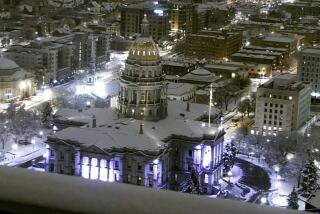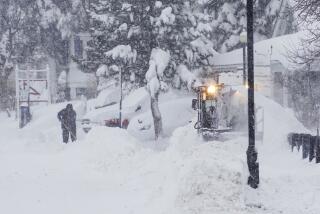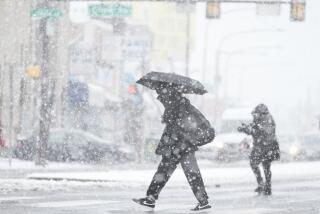Storm Strands Tens of Thousands in Seattle Area
SEATTLE — A punishing winter storm that clamped down on Seattle with a foot of snow and gale winds Tuesday and Wednesday stranded tens of thousands of people, closed schools for the holidays three days early and turned commutes into five- and 10-hour ordeals.
The mayhem left some residents wondering where the pollsters are now to ask about the delights of America’s “most livable city”?
Measurable snow typically can be expected only once or twice a year in the Puget Sound region. Some officials said they had not seen this much--8 to 14 inches--in two decades.
More than 30 schools in the region could not get students home in the traffic madness that began just before rush hour Tuesday, and about 1,500 youngsters spent the night in classrooms. In other areas, the roads of this city of steep hills and narrow bridges were so tangled that school buses did not deliver children home until midnight.
Schools called it quits Wednesday and said classes would not resume until the end of the holiday break, Jan. 7.
Doug Hales at the downtown Westin hotel estimated that 20,000 people--holiday shoppers and businessmen and women--were stranded and forced to look for lodging Tuesday night. Everything from hotel couches to children’s play areas at the suburban Bellevue shopping mall provided makeshift sleeping accommodations.
Transportation officials counted more than 400 buses stuck and abandoned at the height of the snowfall Tuesday night and Wednesday morning. The buses that remained in service were hours behind schedule and frequently wandered from normal routes. Virtually every street in the region was littered with abandoned vehicles--those stuck in the unusually heavy snow or those that simply ran out of gas in the gridlock.
One businessman estimated that he passed 500 abandoned cars in 15 miles.
One of two floating bridges that connect Seattle with suburbs to the east was closed for much of the storm because abandoned vehicles blocked the approaches. One baby was reported being born in the traffic tie-up on the other floating bridge.
The storm was accompanied by lightning and winds of 45 m.p.h., with gusts of 70 m.p.h. in exposed areas. Snows diminished Wednesday and blue skies appeared in the afternoon, but temperatures remained below freezing and were forecast to stay that way for a week.
That meant additional transportation misery as the slush of the early hours of the storm froze into a glaze of hard ice.
Seattle hospitals reported several cases of hypothermia, and at least two heart attack victims died while ambulances fought the traffic.
More than 110,000 customers were without power Wednesday, including virtually everyone on Bainbridge Island to the west.
Ten thousand tickets were sold to Tuesday night’s National Basketball Assn. game between the Seattle Supersonics and the Orlando Magic, but only 1,000 people showed up.
With children, and some parents, home for the week, local television and radio stations broadcast safe sledding rules, reminding youngsters that sledding on city streets is illegal. Municipal golf courses, however, were open for sledding.
The mid-December snow followed two episodes of major flooding in western Washington in November. Some rivers reached near-record flood stage during the Thanksgiving weekend, and some residents are still homeless from that storm.
And what of those researchers who continually name Seattle among the most livable cities in the world? “Oh, they’re all in Hawaii,” joked native Washingtonian Rick Sadler. “They’ll be back in the spring.”
Times researcher Doug Conner contributed to this story.
More to Read
Sign up for Essential California
The most important California stories and recommendations in your inbox every morning.
You may occasionally receive promotional content from the Los Angeles Times.










